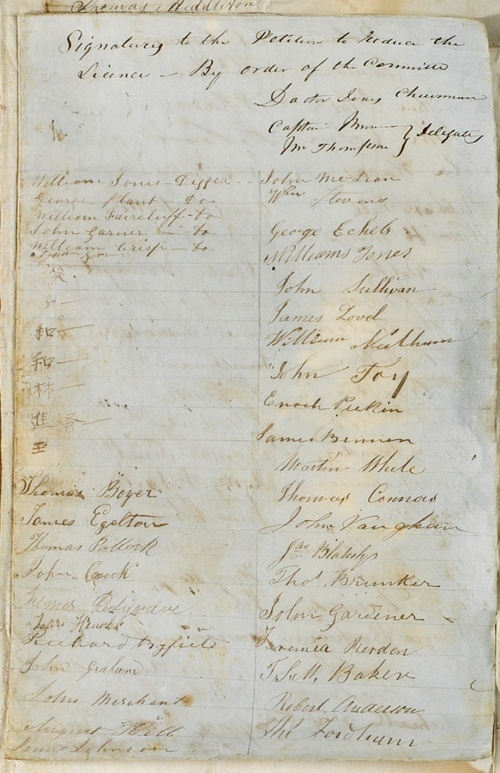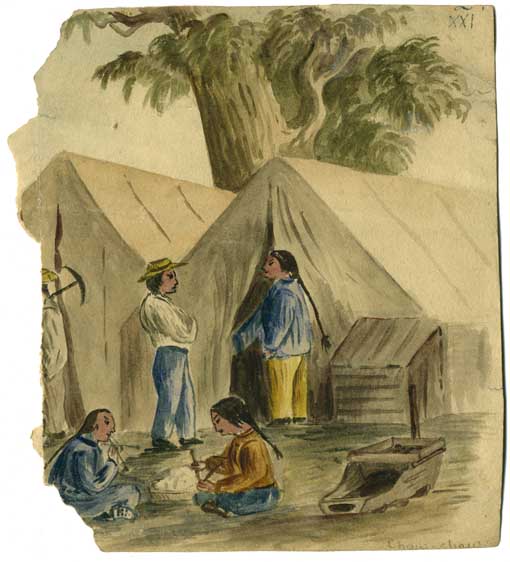Difference between revisions of "China"
Dottigee16 (talk | contribs) |
|||
| (7 intermediate revisions by 2 users not shown) | |||
| Line 1: | Line 1: | ||
[[File:Chinese-GFs Pet 1853 7.jpg|500px|thumb|right| Signatures of Chinese gold diggers on the 1853 Bendigo Goldfields Petition]] | [[File:Chinese-GFs Pet 1853 7.jpg|500px|thumb|right| Signatures of Chinese gold diggers on the 1853 Bendigo Goldfields Petition]] | ||
| − | |||
| − | |||
| + | [[File:1996.64 - Doudiet - Chow Chow (Chinamen on Ballarat)2-wiki.jpg|1000px|thumb|right|Charles A. Doudiet, ''Chow Chow (Chinamen on Ballarat),'' c1854, watercolour, pen and ink on paper. <br>Courtesy Art Gallery of Ballarat, purchased by the Ballarat Fine Art Gallery with the assistance of many donors, 1996.]] | ||
| + | ==1853 Bendigo Goldfields Petition== | ||
Chinese signatures appear on the 1853 Bendigo Goldfields Petition. | Chinese signatures appear on the 1853 Bendigo Goldfields Petition. | ||
| − | Chinese diggers were known to participate in the meetings, ‘their vanguard being preceded by a “long pole with small bells hanging on it”.’ | + | |
| + | On the first of August 1853 [[George Thomson]], [[D.G. Jones]] and an Irish-born American, ‘Captain’ [[Edward Brown]] presented the Bendigo Goldfields Petition to Lieutenant Governor Charles Joseph LaTrobe. Signed by around 5,000 miners from [[Bendigo]], [[Castlemaine]], [[McIvor]] and other Victorian Goldfields, it is an important political document in the history of Victoria. George Edward Thomson, [[Chartist]] and leader of the [[Red Ribbon Movement]], wrote that: ‘Political deliberation is the poor man’s right arm. It brought the Magna Carta to the barons, Catholic emancipation to the Irish and triumphal repeal of the Corn Laws for the people of England. Surely it would bring democracy to the gold diggers of Victoria’. | ||
| + | Drawn up in 1853, the [[Bendigo Goldfields Petition]] was amongst the earliest organised expressions of dissatisfaction with the conditions of the Victorian goldfields. It came out of the meetings of the Anti-Gold Licence Association formed in Bendigo. Chinese diggers were known to participate in the meetings, ‘their vanguard being preceded by a “long pole with small bells hanging on it”.’ | ||
| + | |||
| + | |||
| + | ==Chinese in Bendigo== | ||
| + | Howqua, was a Cantonese man who gave evidence to the Commission on 15 January 1855, pp. 335-338. He had been in the colony almost a year. Before emigrating to Australia Howqua had spent nine years in England. He had left China in 1846. In the 11 months he had spent in Australia he had been digging for gold at Ballarat, Bendigo, Castlemaine, Mopoke, Forest Creek and Simson's. He had found a 'great many' of his countrymen at the diggings, thinking there would be around 10,000 altogether.<re>Ian F. McLaren, The Chinese in Victoria: Official Reports & Documents, Red Rooster Press, 1985.</ref> | ||
| + | |||
| + | ==Chinese in Ballarat== | ||
| + | There were reportedly around 5000 Chinese (mostly men) on the Ballarat Diggings. Abboo Mason was known as the Chinese Interpreter in Ballarat. | ||
| + | |||
| + | The Victorian Government quickly established the Gold Fields' Commission of Enquiry into the Goldfields after the Eureka battle. The Committee recommended under the heading of 'Social Condition' some restrictions be placed upon Chinese immigration.Taxes and other restrictive measures were enforced. This resulted that, in an attempt to avoid the landing tax of 10 pounds that many Chinese men disembarked in South Australian ports and then marched the long journey from places like Robe, SA, to goldfields like Ballarat or Bendigo. A further Select Committee to review the Chinese in the goldfields was established in 1857.<re>Ian F. McLaren, The Chinese in Victoria: Official Reports & Documents, Red Rooster Press, 1985.</ref> | ||
Latest revision as of 21:45, 6 November 2021
1853 Bendigo Goldfields Petition
Chinese signatures appear on the 1853 Bendigo Goldfields Petition.
On the first of August 1853 George Thomson, D.G. Jones and an Irish-born American, ‘Captain’ Edward Brown presented the Bendigo Goldfields Petition to Lieutenant Governor Charles Joseph LaTrobe. Signed by around 5,000 miners from Bendigo, Castlemaine, McIvor and other Victorian Goldfields, it is an important political document in the history of Victoria. George Edward Thomson, Chartist and leader of the Red Ribbon Movement, wrote that: ‘Political deliberation is the poor man’s right arm. It brought the Magna Carta to the barons, Catholic emancipation to the Irish and triumphal repeal of the Corn Laws for the people of England. Surely it would bring democracy to the gold diggers of Victoria’. Drawn up in 1853, the Bendigo Goldfields Petition was amongst the earliest organised expressions of dissatisfaction with the conditions of the Victorian goldfields. It came out of the meetings of the Anti-Gold Licence Association formed in Bendigo. Chinese diggers were known to participate in the meetings, ‘their vanguard being preceded by a “long pole with small bells hanging on it”.’
Chinese in Bendigo
Howqua, was a Cantonese man who gave evidence to the Commission on 15 January 1855, pp. 335-338. He had been in the colony almost a year. Before emigrating to Australia Howqua had spent nine years in England. He had left China in 1846. In the 11 months he had spent in Australia he had been digging for gold at Ballarat, Bendigo, Castlemaine, Mopoke, Forest Creek and Simson's. He had found a 'great many' of his countrymen at the diggings, thinking there would be around 10,000 altogether.<re>Ian F. McLaren, The Chinese in Victoria: Official Reports & Documents, Red Rooster Press, 1985.</ref>
Chinese in Ballarat
There were reportedly around 5000 Chinese (mostly men) on the Ballarat Diggings. Abboo Mason was known as the Chinese Interpreter in Ballarat.
The Victorian Government quickly established the Gold Fields' Commission of Enquiry into the Goldfields after the Eureka battle. The Committee recommended under the heading of 'Social Condition' some restrictions be placed upon Chinese immigration.Taxes and other restrictive measures were enforced. This resulted that, in an attempt to avoid the landing tax of 10 pounds that many Chinese men disembarked in South Australian ports and then marched the long journey from places like Robe, SA, to goldfields like Ballarat or Bendigo. A further Select Committee to review the Chinese in the goldfields was established in 1857.<re>Ian F. McLaren, The Chinese in Victoria: Official Reports & Documents, Red Rooster Press, 1985.</ref>

